
The Wyandot people are Indigenous peoples of the Northeastern Woodlands of North America, and speakers of an Iroquoian language, Wyandot.

The Ojibwe are an Anishinaabe people whose homeland covers much of the Great Lakes region and the northern plains, extending into the subarctic and throughout the northeastern woodlands. Ojibweg are known by several names, including Ojibway or Chippewa. As a large ethnic group, several distinct nations also understand themselves to be Ojibwe as well, including the Saulteaux, Nipissings, and Oji-Cree.

The Potawatomi, also spelled Pottawatomi and Pottawatomie, are a Native American people of the Great Plains, upper Mississippi River, and western Great Lakes region. They traditionally speak the Potawatomi language, a member of the Algonquian family. The Potawatomi call themselves Neshnabé, a cognate of the word Anishinaabe. The Potawatomi are part of a long-term alliance, called the Council of Three Fires, with the Ojibway and Odawa (Ottawa). In the Council of Three Fires, the Potawatomi are considered the "youngest brother". Their people are referred to in this context as Bodéwadmi, a name that means "keepers of the fire" and refers to the council fire of three peoples.
In Canada, an Indian reserve is defined by the Indian Act as a "tract of land, the legal title to which is vested in His Majesty, that has been set apart by His Majesty for the use and benefit of a band." Reserves are areas set aside for First Nations, one of the major groupings of Indigenous peoples in Canada, after a contract with the Canadian state, and are not to be confused with Indigenous peoples' claims to ancestral lands under Aboriginal title.

The Odawa are an Indigenous American people who primarily inhabit land in the Eastern Woodlands region, now in jurisdictions of the northeastern United States and southeastern Canada. Their territory long preceded the creation of the current border between the two countries in the 18th and 19th centuries.

The Wyandotte Nation is a federally recognized Native American tribe headquartered in northeastern Oklahoma. They are descendants of the Wendat Confederacy and Native Americans with territory near Georgian Bay and Lake Huron. Under pressure from Haudenosaunee and other tribes, then from European settlers and the United States government, the tribe gradually moved south and west to Michigan, Ohio, Kansas, and finally Oklahoma in the United States.
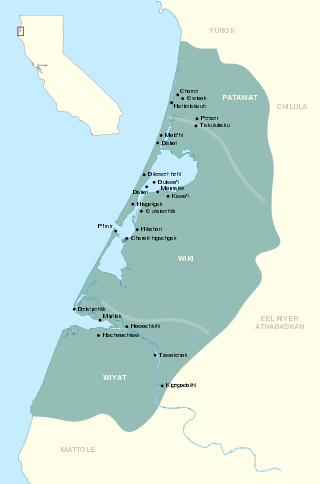
The Wiyot are an indigenous people of California living near Humboldt Bay, California and a small surrounding area. They are culturally similar to the Yurok people. They called themselves simply Ku'wil, meaning "the People". Today, there are approximately 450 Wiyot people. They are enrolled in several federally recognized tribes, such as the Wiyot Tribe, Bear River Band of the Rohnerville Rancheria, Blue Lake Rancheria, and the Cher-Ae Heights Indian Community of the Trinidad Rancheria.

The Musqueam Nation is a First Nation whose traditional territory encompasses the western half of what is now Greater Vancouver, in British Columbia, Canada. It is governed by a band council and is known officially as the Musqueam Indian Band under the Indian Act. "Musqueam" is an anglicization of the Hunquminum name xʷməθkʷəy̓əm, which means "place of the river grass" or "place where the river grass grows".

The Yurok are an Indigenous peoples of California from along the Klamath River and Pacific coast, whose homelands stretch from Trinidad in the south to Crescent City in the north.
Deborah A. Miranda is an American writer, poet, and professor of English at Washington and Lee University. Her father, Alfred Edward Robles Miranda, is of self-identified Esselen and Chumash descent. Her mother, Madgel Eleanor (Yeoman) Miranda, was of French and Jewish ancestry. Miranda claims descent from what are known as "Mission Indians," Indigenous peoples of many Southern California tribes who were forcibly removed from their land into several Franciscan missions. She is a member of the Ohlone-Costanoan Esselen Nation, an unrecognized organization that identifies as a tribe.
The Robinson Treaties are two treaties signed between the Ojibwa chiefs and the Crown in 1850 in the Province of Canada. The first treaty involved Ojibwa chiefs along the north shore of Lake Superior, and is known as the Robinson Superior Treaty. The second treaty, signed two days later, included Ojibwa chiefs from along the eastern and northern shores of Lake Huron, and is known as the Robinson Huron Treaty. The Wiikwemkoong First Nation did not sign either treaty, and their land is considered "unceded".
The Saugeen Ojibway Nation Territory, also known as Saugeen Ojibway Nation, SON and the Chippewas of Saugeen Ojibway Territory, is the name applied to Chippewas of Nawash Unceded First Nation and Saugeen First Nation as a collective, represented by a joint council. The collective First Nations are Ojibway (Anishinaabe) peoples located on the eastern shores of Lake Huron on the Bruce Peninsula in Ontario, Canada. Though predominantly Ojibway, due to large influx of refugees from the south and west after the War of 1812, the descendants of the Chippewas of Saugeen Ojibway Territory also have ancestry traced to Odawa and Potawatomi peoples.
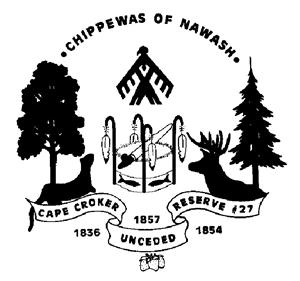
Chippewas of Nawash Unceded First Nation is an Anishinaabek First Nation from the Bruce Peninsula region in Ontario, Canada. Along with the Saugeen First Nation, they form the Saugeen Ojibway Nation. The Chippewas of Nawash Unceded First Nation had a registered membership of 2758 individuals, as of December 2020. Approximately 700 members live on the main reserve, Neyaashiinigmiing 27. The First Nation has 3 reserves, Neyaashiinigmiing 27, Cape Croker Hunting Ground 60B and Saugeen and Cape Croker Fishing Islands 1. The size of all reserves is 8083.70 hectares.

Tuluwat Island is located on Humboldt Bay within the city of Eureka, California. The 1860 Wiyot Massacre was perpetrated in the village of Tolowot or Tuluwat on this island. A National Historic Landmark encompasses the midden at Gunther Island Site 67. Since October 21, 2019, the Wiyot people have had the land deed to most of the Island.
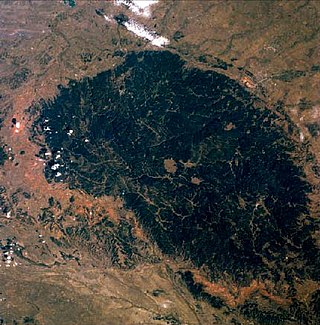
The United States government illegally seized the Black Hills – a mountain range in the US states of South Dakota and Wyoming – from the Sioux Nation in 1876. The land was pledged to the Sioux Nation in the Treaty of Fort Laramie, but a few years later the United States illegally seized the land and nullified the treaty with the Indian Appropriations Bill of 1876, without the tribe's consent. That bill "denied the Sioux all further appropriation and treaty-guaranteed annuities" until they gave up the Black Hills. A Supreme Court case was ruled in favor of the Sioux in 1980. As of 2011, the court's award was worth over $1 billion, but the Sioux have outstanding issues with the ruling and have not collected the funds.

Indigenous peoples of California, commonly known as Indigenous Californians or Native Californians, are a diverse group of nations and peoples that are indigenous to the geographic area within the current boundaries of California before and after European colonization. There are currently 109 federally recognized tribes in the state and over forty self-identified tribes or tribal bands that have applied for federal recognition. California has the second-largest Native American population in the United States.
The Wiyot Tribe, California is a federally recognized tribe of Wiyot people. They are the aboriginal people of Humboldt Bay, Mad River and lower Eel River of California.
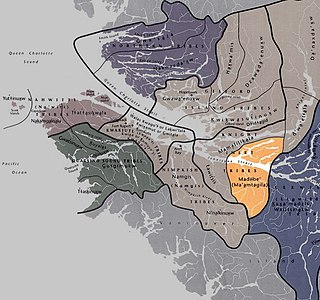
The Ma’amtagila First Nation (also styled Maamtagila), formerly known as Mahteelthpe or Matilpi, are an Indigenous nation and part of the Kwakwaka'wakw peoples. Their territory is located in the Queen Charlotte Strait-Johnstone Strait area in the Discovery Islands between Vancouver Island and the British Columbia mainland in Canada.
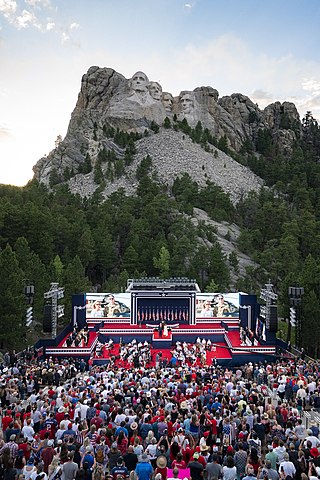
A Fireworks Celebration at Mount Rushmore held on July 3, 2020, was the first and only use of fireworks at Mount Rushmore since 2008. President Donald Trump spoke at the event, which was also attended by South Dakota Governor Kristi Noem, host of Entertainment Tonight Mary Hart, First Lady Melania Trump and Trump's eldest son Donald Trump Jr.
NDN Collective is an indigenous-led activist and advocacy organization based in Rapid City, South Dakota, United States. Founded in 2018, NDN Collective works with more than 200 Indigenous-led groups in the U.S. NDN Collective's mission is "Build the collective power of Indigenous Peoples, communities, and Nations to exercise our inherent right to self-determination, while fostering a world that is built on a foundation of justice and equity for all people and the planet." and includes "defend: our people, communities, and nations; develop: Indigenous communities in a regenerative and sustainable manner, and decolonize: our minds, communities, and sovereign nations." According to president and CEO Nick Tilsen, NDN Collective has "an overall strategy to shift power, decolonize wealth, and resource Indigenous people who are on the front lines of fighting for justice and equity." NDN is operated entirely by Indigenous leadership, board, and staff that come from over 25 Tribal Nations.














